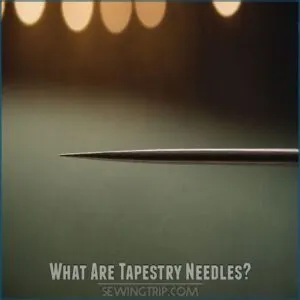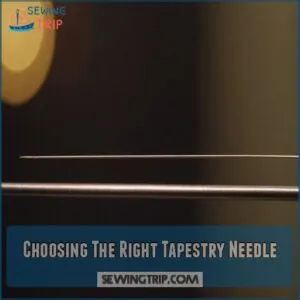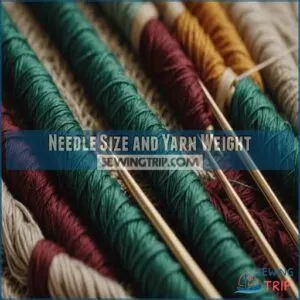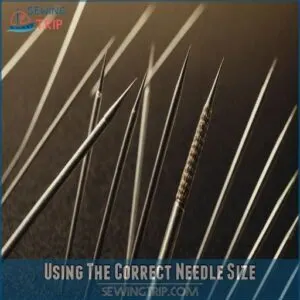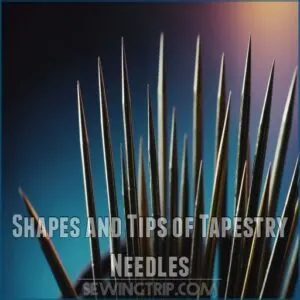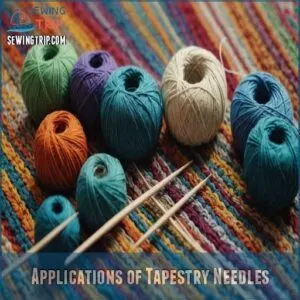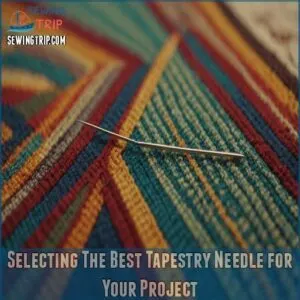This site is supported by our readers. We may earn a commission, at no cost to you, if you purchase through links.
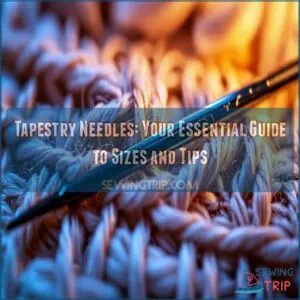
These handy tools come in various styles: bent tips for tricky spots and blunt ends that glide through yarn smoothly.
Metal, plastic, and wood are popular materials, each offering its own perks.
Metal needles? They’re strong and durable.
Go for plastic if you’re on a budget, or try wood for an eco-friendly touch.
Needle size matters too—thicker for chunky yarn, slimmer for fine threads.
With the right needle, you’ll stitch with ease, and who knows? Your masterpiece might just stitch itself!
Curious to learn more?
Table Of Contents
- Key Takeaways
- What Are Tapestry Needles?
- Choosing The Right Tapestry Needle
- Sizes of Tapestry Needles
- Shapes and Tips of Tapestry Needles
- Using Tapestry Needles
- Applications of Tapestry Needles
- Tips for Working With Tapestry Needles
- Selecting The Best Tapestry Needle for Your Project
- Frequently Asked Questions (FAQs)
- Conclusion
Key Takeaways
- You’ll find tapestry needles essential for crafting, with their blunt tips and large eyes perfect for threading thicker yarns.
- Choose from materials like metal for durability, plastic for budget-friendly options, or wood for an eco-friendly touch.
- Match needle size to your yarn: thicker needles for chunky yarns and slimmer ones for fine threads to ensure smooth crafting.
- Explore different needle types for your projects; bent tips help with tricky spots while straight needles are versatile workhorses.
What Are Tapestry Needles?
You might be wondering what tapestry needles are and why they’re essential for your craft projects.
Simply put, they’re blunt needles with large eyes, perfect for threading thicker yarns.
They come in various sizes, materials, and shapes to suit any creative need—no magic wand required!
Types of Tapestry Needles
You’ll often find several types of tapestry needles!
There are bent tip needles, perfect for weaving in those tricky spots. Then there are blunt needles, ideal for smoothly gliding through your yarn. Don’t forget the trusty straight needles, your all-around workhorses.
Choosing the right one depends on your project—it’s all about finding the perfect fit!
Consider materials too; you can find metal, plastic, or even handmade needles.
Happy stitching!
Characteristics of Tapestry Needles
Switching gears from the types of tapestry needles, let’s chat about what makes them unique.
These needles sport blunt ends, making yarn passage smooth, with large eyes for easy threading.
Sizes vary to accommodate different yarn weights, and a needle threader might just become your best friend.
Whether you’re into bulky yarn or embroidery floss, these needles have your back!
Materials Used for Tapestry Needles
Why not explore what tapestry needles are made of? Options include metal, plastic, and even wood.
Metal needles are durable, perfect for tough jobs, but need care to prevent rust.
Plastic needles are light and cheap but can snap like a twig.
Feeling fancy? Try wood needles for comfort and eco-friendliness.
Each material brings unique flair to your crafting adventure!
Choosing The Right Tapestry Needle
When choosing the right tapestry needle, you’ll need to factor in the material—whether metal, plastic, or wood—and how it fits your project needs.
Selecting the perfect needle is a bit like choosing an ice cream flavor: it depends on what you’re working with and what feels right to you!
Metal Tapestry Needles
Choosing metal tapestry needles is like finding the perfect dance partner for your yarn. Strong and durable, they glide effortlessly through fibers, making tasks a breeze.
Remember to store them properly to avoid dullness. Consider DIY needle cases for safe storage.
Whether weaving in ends or tackling a Bernat Blanket, these needles have your back—just don’t get poked!
Plastic Tapestry Needles
You’ve heard about metal’s durability, but plastic tapestry needles are lightweight champs in your crafting arsenal.
Ideal for beginners and budget-friendly projects, they’re crafted through plastic injection molding.
For harder-to-find large tapestry needle options, you can check out online marketplaces like large tapestry needle suppliers.
While not the greenest option, these cheap needle suppliers make them widely available, allowing you to save on your next weaving project.
Plus, they’re perfect for teaching kids or practicing new stitches!
Wood Tapestry Needles
Beyond their smooth, elegant look, wood tapestry needles offer a surprisingly comfortable grip.
They’re a splurge, but worth it, especially when paired with the right embroidery needles and tools.
Here’s why you might love them:
- Hand-carved wooden options add a touch of artistry to your craft.
- Wooden needle durability is surprisingly good with proper care.
- They’re great for various projects, from working with Aida fabric, to cross stitch to joining crocheted fabric.
- Wood needle maintenance is minimal; just a gentle wipe after use.
Sizes of Tapestry Needles
When choosing the right tapestry needle, size really does matter—
because nobody wants to wrangle a bulky needle with delicate yarn or vice versa.
Understanding the correlation between needle size and yarn weight, such as the recommended 4-4.5 mm needles for DK weight yarn, guarantees your crafting journey is as smooth as a freshly buttered pancake.
Needle Size and Yarn Weight
Ever wondered why size matters in tapestry needles?
It’s all about matching the needle to your yarn’s weight. A larger needle suits chunky yarn, while a smaller one pairs nicely with fine threads.
Check out a Needle Gauge Chart to find the perfect fit. Think of it as choosing the right tool—like using a pick-up stick for precise work!
Using The Correct Needle Size
Choosing the right tapestry needle size feels like finding the perfect melody for your favorite song.
When choosing the right yarn needle, consider the type and size of the yarn you’re using, such as large, blunt plastic needles for thick yarn or small steel needles for fine threads, as explained in yarn needle types and sizes. Use a needle size conversion chart to match your yarn weight. This helps in avoiding yarn breakage and minimizing fabric distortion.
Remember, thicker needles pair with thicker yarns.
Own your craft by choosing correct thickness with a simple yarn weight gauge. Happy crafting!
Shapes and Tips of Tapestry Needles
When choosing a tapestry needle, you’ll find that straight needles work great for everyday weaving.
While bent tip needles are perfect for tighter spots without leaving you in knots.
Don’t be surprised if you fall for the debate of pointy versus blunt ends, as each has its unique charm—pointy for precision and blunt for smoother yarn flow.
Straight Tapestry Needles
A straight tapestry needle is your trusty sidekick in crafting, gliding smoothly through projects.
It’s the go-to for basic weaving and finishing, providing precise ergonomic handling.
Maintain tapestry needle care by storing them in a secure spot.
Keep them sharp with regular needle sharpening.
Safety first—mind your fingers and avoid clutter when working for the best results!
Bent Tip Tapestry Needles
Imagine weaving in those tight corners without a hitch—bent tip tapestry needles come to the rescue!
They are perfect for reaching tricky spots, and these needles make your work a breeze.
Remember, good care keeps them sharp and ready. Tuck them safely in a needle case when not in use, and they’ll reward you with smooth stitching every time.
Happy crafting!
Pointy Vs Blunt Needles
Bent tip needles might seem like your best buds for tight spots, yet consider pointy vs. blunt tips next.
Each has a special charm.
- Blunt tips slide smoothly, perfect for hooking safety and avoiding needle damage.
- Pointy tips excel in fiber piercing, great for tighter weaves.
- Adjusting your technique tackles thread tension, like comparing nuclear vs. solar power options.
Using Tapestry Needles
When you’re using tapestry needles, threading them and weaving in ends can sometimes feel like threading a camel through the eye of a needle—but don’t worry, it’s simpler than it sounds!
With a little practice, you’ll be sewing seams and completing projects like a pro, making you wonder why you didn’t pick up tapestry needles sooner.
Threading The Needle
Feeling ready for threading? Tapestry needles can seem tricky, especially if you’ve got a small eye or thick yarn in hand. An alternative to a needle threader is just patience and practice.
Choosing the right needle size is crucial, as larger sizes are best suited for thicker threads, and it’s recommended to refer to machine embroidery needles for specific guidance. Remember, needle size selection matters for easy threading without tangles.
Here’s a snapshot:
| Issue | Solution |
|---|---|
| Needle Threader Use | Try patience |
| Threading Small Eyes | Go slowly |
| Yarn Tangle Prevention | Pick right size |
| Threading Thick Yarn | Use large eyes |
Weaving in Ends
Tying off loose ends can be a real smooth ride with a tapestry needle.
Carefully weave the tail back through your weave patterns, securing ends beautifully without a trace.
Use blunt needles for finishing techniques or adding fringe design. This extra step enhances your piece while letting you showcase true tapestry needle care mastery.
Sewing Seams
Now that those ends are neatly tucked away, let’s move on to sewing seams!
Use a tapestry needle—it’s perfect for this. Choose a needle size that matches your fabric’s weight.
For a strong seam, consider Seam Reinforcement techniques.
Small, even stitches create Invisible Stitches.
Remember, the right Seaming Techniques are key to a beautiful finish.
Experiment with Edge Finishing for a professional look.
And don’t forget to account for Fabric Stretch!
Applications of Tapestry Needles
When you pick up a tapestry needle, you’re not just holding a tool—you’re holding the key to countless creative projects from cross-stitch and embroidery on crochet to joining afghan squares.
Whether you’re crafting a cozy blanket or adding intricate designs to your latest crochet piece, these versatile needles will have you stitching with flair in no time!
Cross Stitching or Embroidering on Crochet Work
Jump into the colorful world of cross-stitching or embroidering on crochet work!
To master intricate crochet embroidery patterns, you can start by learning basic stitches such as the running stitch, backstitch, and French knots, which are essential for hand embroidery techniques. With the right tapestry needle, you can create intricate crochet embroidery patterns by combining striking stitch techniques and imaginative project ideas.
Choose your yarn color wisely to enhance your design.
A tapestry needle with a large eye makes threading a breeze, turning your crochet projects into eye-catching art.
Needlepoint and Embroidery
Feeling inspired by cross-stitching on crochet? Let’s jump into needlepoint and embroidery.
Use tapestry needles to tackle needlepoint stitches and create beautiful embroidery patterns.
To get the perfect tools for your project, consider shopping for tapestry yarn needles online.
Choose threads wisely for vibrant results.
Different canvas types can spice up your project ideas.
Remember, the right needle can make or break your masterpiece.
Explore, experiment, and enjoy the art of handy creativity!
Joining Afghan Squares
Got a needlepoint project finished? It’s time to face those Afghan squares.
With tapestry needles, enjoy a seamless connection through creative joining methods like the invisible seam join technique learn more about joining granny squares by sewing.
Consider these tips:
- Afghan square techniques allow flexibility with size variations.
- Different joining methods add unique texture.
- Finishing touches mean everything—like sprinkles on a cupcake!
Don’t worry, it’ll be pretty as pie!
Tips for Working With Tapestry Needles
When working with tapestry needles, choose the right size to avoid turning your project into a wobbly masterpiece worthy of a funhouse.
Don’t be afraid to try different needle types—treat it like a friendly game of Goldilocks until you find the one that fits just right.
Avoiding Distortion
To avoid distortion in your tapestry projects, focus on yarn tension, needle size, and fabric type.
Stitch selection matters too!
Imagine your project design as a jigsaw puzzle; each piece must fit just right.
Keep your yarn relaxed, not too tight.
And remember, a massive needle with a delicate thread might cause chaos—just like using a forklift to move cotton candy!
Experimenting With Different Needles
Because experimenting is half the fun, try different needle sizes. The right needle size depends on your yarn thickness; a thicker yarn needs a larger needle.
Remember, a tapestry needle‘s large eye and blunt, bent tip, as found in nickel-plated steel tapestry needles, are designed to accommodate various yarn gauges and make weaving easier.
Needle shape also matters; a bent needle’s great for tight spots, while a straight one’s better for finishing. The material impacts your grip; some find wood more comfortable.
- Experiment with needle size and yarn thickness.
- Note how needle shape affects your weaving.
- Consider the material’s impact on your grip.
- Discover your personal preferences!
Selecting The Best Tapestry Needle for Your Project
Choosing the perfect tapestry needle can feel like picking the right wand—consider your project size and yarn weight to guarantee magical results.
Don’t forget your personal preference; finding a needle that feels just right in your hand can make all the difference in enjoying your crafting journey.
Considering Yarn Weight and Project Size
Choosing the right tapestry needle feels like matchmaking for crafts. Yarn weight and project size dictate your ideal partner.
You can find a variety of tapestry needles online at an embroidery supplies store.
Needle size matters; smaller ones love delicate yarns, while larger ones cuddle with bulkier threads.
Don’t overlook needle length—a longer needle speeds up wide projects!
Experimenting can be a needle in a haystack moment, but aha, it’s worth it!
Personal Preference and Grip Comfort
While yarn weight dictates needle size, your comfort matters too.
If you’re crafting for hours, an ergonomic design can minimize hand fatigue, and it’s also essential to consider the material, such as warm and comfortable bamboo knitting needles.
Think about a needle grip that feels just right.
Metal offers sturdiness, while wood gives a softer touch—your preferred material might be different.
Remember, a thicker needle doesn’t always mean better; let comfort guide you.
Frequently Asked Questions (FAQs)
What is a tapestry needle used for?
Imagine this: a tapestry needle is your best crafting buddy!
You’ll use it to weave in ends, sew seams, and join squares in knitting or crochet projects.
It works wonders for cross-stitching or embroidering, too!
What is the difference between a tapestry needle and a normal needle?
Tapestry needles have a blunt tip and large eye for threading yarn, making them perfect for weaving and embroidery.
Normal needles often have sharp tips and small eyes for sewing fabrics, designed for precise stitches, which may not be suitable for certain types of fabrics, such as delicate or thick materials.
Why do you need a tapestry needle for knitting?
Knitting isn’t just needles dancing with yarn; it’s about finishing.
Enter the tapestry needle: essential for weaving in loose ends and sewing seams, it smoothly passes through yarn, ensuring your project doesn’t unravel over time.
Are tapestry and yarn needles the same?
You’re right if you think tapestry and yarn needles seem similar—they are!
Both have large eyes for easy threading.
But, tapestry needles often have blunt tips, perfect for weaving through knits without snagging.
Can I reuse tapestry needles?
Absolutely, you can reuse tapestry needles.
They’re durable and designed for multiple uses, especially if they’re metal.
Just make sure they’re not bent or damaged, and they should keep threading through your crafty projects seamlessly!
Where can I buy tapestry needles?
Finding tapestry needles is easier than spotting a needle in a haystack!
Check craft stores like Michaels, Joann, or Hobby Lobby.
Online giants like Amazon and Etsy also offer an endless variety.
Happy crafting, stitch by stitch!
How do I sharpen a dull needle?
Don’t try sharpening a dull needle!
It’s safer and easier to just replace it.
A blunt needle can snag your fabric, leading to frustration and potentially ruining your project.
Trust me, a new needle is cheaper than fixing a mistake!
What are tapestry needle alternatives?
If you’re searching for tapestry needle alternatives, consider darning needles or blunt-tipped sewing needles.
They’re great for similar crafts, like weaving or embroidery.
You might even find larger crochet hooks handy for threading bulky yarns!
Do tapestry needles rust easily?
You might worry about metal tapestry needles rusting, but they typically don’t if they’re stored properly.
Keep them dry and in a cool place.
Plastic needles don’t rust, just watch out for breaks instead!
Conclusion
Ever notice how a tapestry needle can make or break your crafting experience?
Choosing the right one can be the secret ingredient to success.
Whether you’re threading needlepoint or joining afghan squares, each needle type has its own perks.
Keep experimenting with different sizes and materials—metal for strength, plastic for budget-friendly options, or wood for an eco-chic touch.
Remember, the right needle can transform your projects into works of art with ease and flair!

